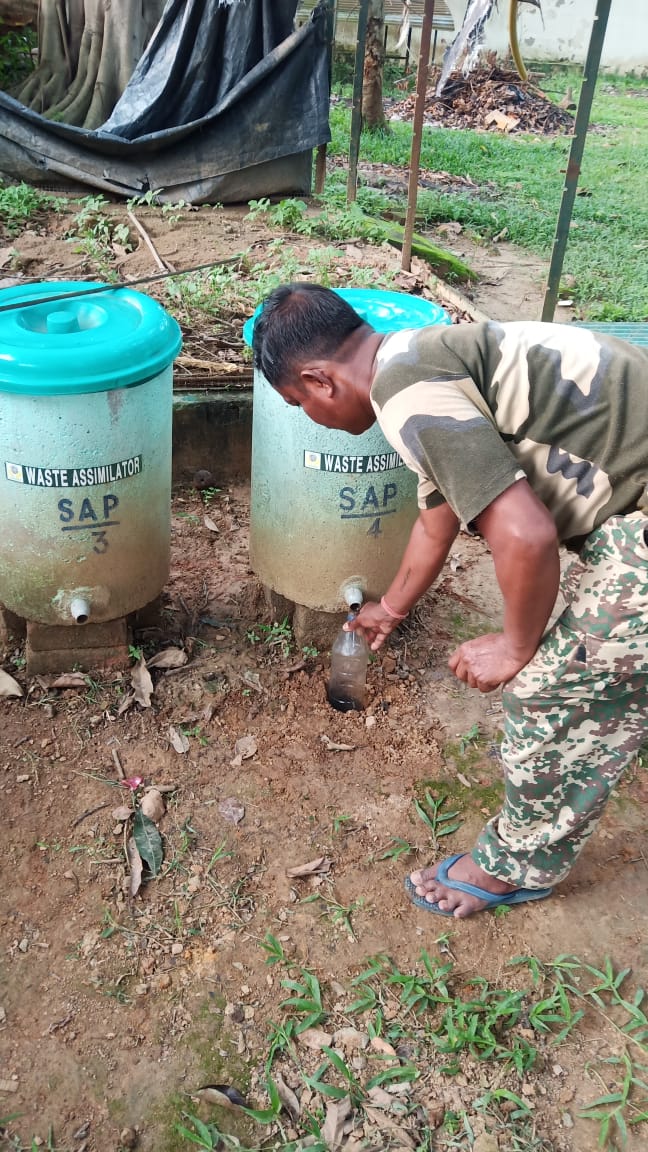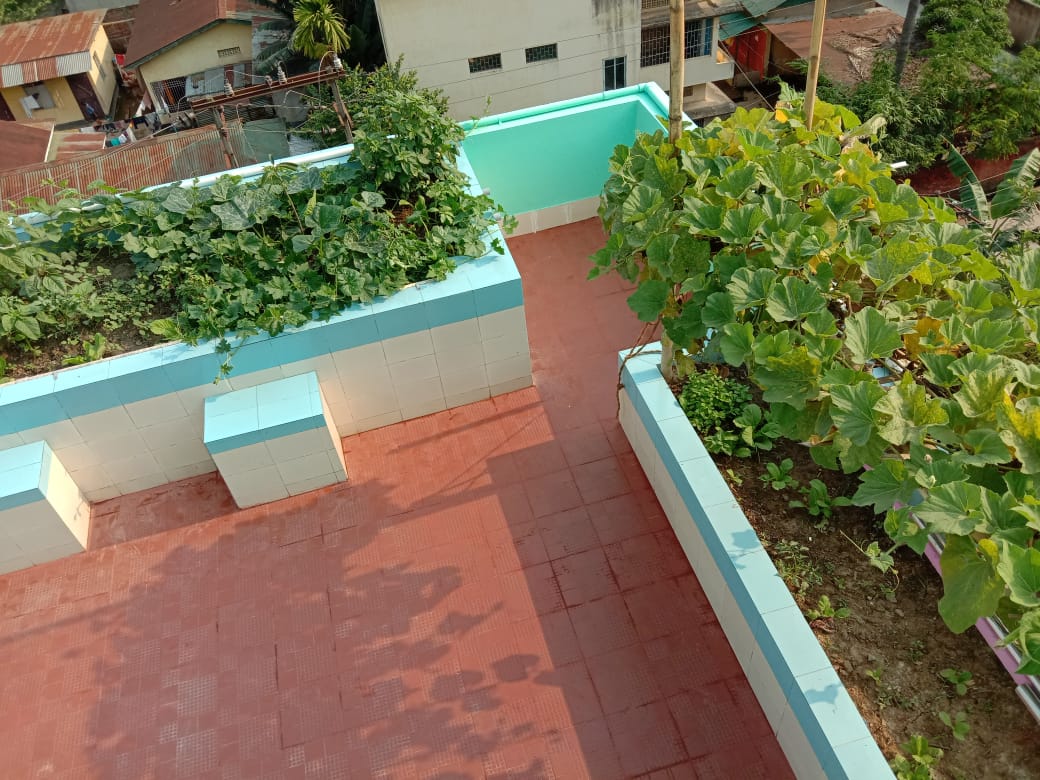Assam Man Farms Fish in Rooftop Pond, Turns Kitchen Waste into Bio-Pesticides!
Guwahati-based environmental scientist, Dr Amarjyoti Kashyap, has created a pond on the rooftop of his two-storey building on LNB Road at Hatigaon. He has been rearing and cultivating fish for the last one month.

Life is but a stream, and we go fishing in! Got no space to fish? You could do it in your own home!
Confused?
You may have heard of urban farms or rooftop kitchen gardens. But what if I said that you could breed and cultivate fish on your rooftop too?
Well, Guwahati-based environmental scientist, Dr Amarjyoti Kashyap, has created a pond on the rooftop of his two-storey building on LNB Road at Hatigaon. He has been rearing and cultivating fish for the last one month.
What is rooftop fishing?

It is a form of aquaculture in a limited space, like the rooftop or terrace. The technique can prove useful for urban farmers who want to cultivate fish for consumption or on a commercial scale but lack the space to do so.
Dr Kashyap, who heads Environ, an NGO promoting waste management and sustainable practices, shares that the technique could be an option in cities, where most people do not have enough land for conventional fish farming.
With an initial investment of Rs 50,000, a pond like this could help urban farmers generate additional income in the long run, he believes.
Speaking to The Better India, he says, “You can consume and sell it too. Another brownie point is the beauty it adds to the rooftop. I have utilised 1,000 sq ft from my rooftop to build the natural pond and a recreation centre—14 feet wide, 28 feet long and 4 feet deep. Presently, it breeds Golden Carp. I have set up umbrellas, under which you can relax and enjoy the view while sipping refreshments.”
Formerly a professor of environmental sciences at Lalit Chandra Bharali College and Gauhati University, Kashyap quit his job in the early 2000s to set up an NGO, Environ. It has now turned into a research organisation.
In line with the Swachh Bharat Mission, Environ has been promoting solid waste management and organic rooftop gardening. The environmental scientist Dr Kashyap is known for the award-winning concept of waste assimilator.
Waste Assimilator

Developed in 2005, it is a method that allows households to turn solid organic waste into vermicompost and pest-repellants within a day. Today, over 12,000 people use these waste assimilators and its byproducts for organic rooftop gardening, claims Kashyap.
While he has received a provisional patent for the waste assimilator, he is yet to get the final patent.
He explains, “The idea of the ‘Waste Assimilator’ is to manage all the biodegradable solid waste within the residential campus. The invention has introduced the concept of producing ‘bio-pest repellant’ and ‘organic manure’ in the form of ‘micronutrients’, ‘vermiwash’ and finally ‘vermicompost’ at the household level. It also inspires people to take up organic farming and resolve 80 per cent of the domestic solid waste problems by reducing the pressure on dumpsites. Bigger communities adopting the concept can also process waste at source and gain an income from it.”
How does it work?

- The waste assimilator uses a plastic bin or a concrete ring, the capacity of which can differ based on its household or community use. It needs space of at least 2.25 square feet and can be kept inside the balcony of an apartment.
- In this process, per day, 1-2 kg of biodegradable waste is deposited inside the assimilator for 60-180 days or until it fills up. The decomposition of waste releases micronutrients in liquid form, which is collected.
- Twenty-five days after this, 100 earthworms are added to the assimilator, releasing ‘vermiwash’ which is collected through an outlet.
- Two waste assimilators are required for the continuity of the process, so that when one container fills up, you can use the other one.
How is it beneficial?

“Today, one of the major issues with practising organic farming is that cow dung or vermicompost isn’t enough. Because once pests attack, it pushes farmers to use chemicals. So the liquid that comes out of the waste assimilator can be used as a bio-pest repellent. Since the climate of Assam is suitable for tea gardening, we are now propagating rooftop green tea gardens with the use of the vermicompost and vermiwash.”
The man has dedicated space on his terrace in Guwahati to growing 30 organic green tea plants, claiming that it has fetched him an income of Rs 1 lakh. He believes growing green tea can be a profitable venture since it contains epigallocatechin-3 gallate, an antioxidant which helps treat a variety of diseases. For instance, protecting your brain in old age; lowering the risk of Alzheimer’s. Parkinson’s and the risk of Type 2 Diabetes; and preventing cell damage.
“When upscaled, not only does it provide health benefits but also good economic benefits,” he adds.
In an era where most cities are grappling with the formation of heat islands, he thinks developing rooftops could be a good measure to tackle pollution and beautify urban spaces.
“My terrace has a space of 4,000 sq ft. Apart from the recreation centre and rooftop pond that take up 1,000 sq ft, I have set up an organic kitchen garden in 1,000 sq ft where I grow most seasonal vegetables like ladies fingers, brinjals, bottle gourds, cauliflowers, cabbages, medicinal herbs, and leafy greens. I do not purchase veggies from the market at all. The production is surplus, so apart from fulfilling our requirements, we often distribute them to neighbours and friends.”
As open spaces disappear in cities, he aims to develop the remaining 2,000 sq ft area on his rooftop for children to play and reclaim their childhood.
You May Also Like: Working for 35 Years, Ex-Banker Grows Lush 2 Acre Forest in the Middle of Kochi!
Dr Kashyap and team Environ are working on different sustainable projects in the northeast region. We wish them the very best.
If this story inspired you, get in touch with him on [email protected].
(Edited by Shruti Singhal)
Images courtesy: Dr Amarjyoti Kashyap
Like this story? Or have something to share?
Write to us: [email protected]
Connect with us on Facebook and Twitter.
If you found our stories insightful, informative, or even just enjoyable, we invite you to consider making a voluntary payment to support the work we do at The Better India. Your contribution helps us continue producing quality content that educates, inspires, and drives positive change.
Choose one of the payment options below for your contribution-
By paying for the stories you value, you directly contribute to sustaining our efforts focused on making a difference in the world. Together, let’s ensure that impactful stories continue to be told and shared, enriching lives and communities alike.
Thank you for your support. Here are some frequently asked questions you might find helpful to know why you are contributing?


This story made me
-
97
-
121
-
89
-
167











